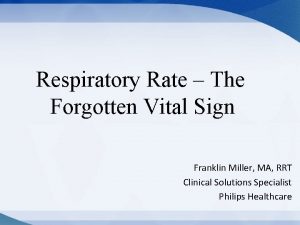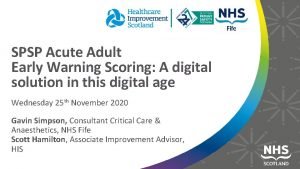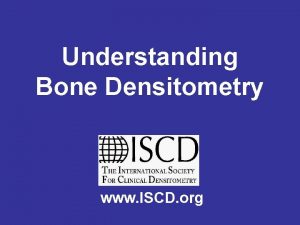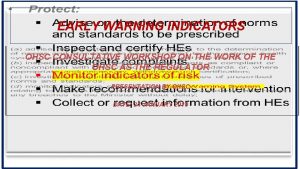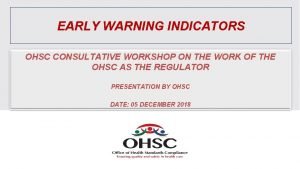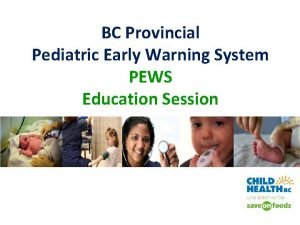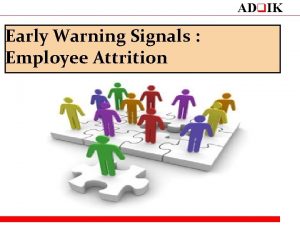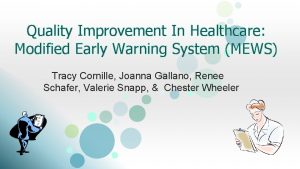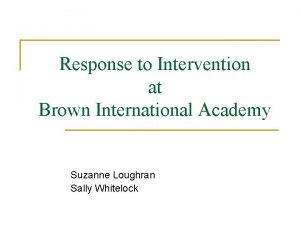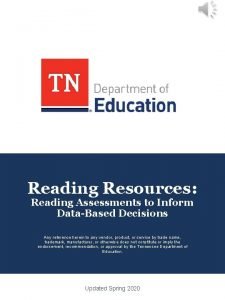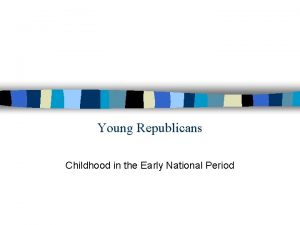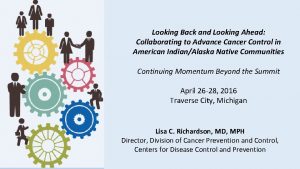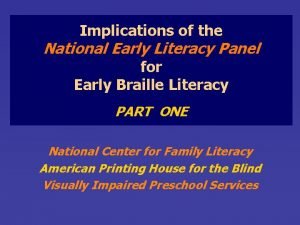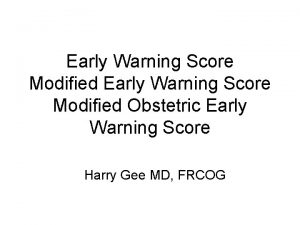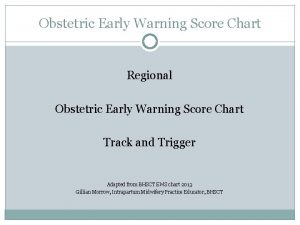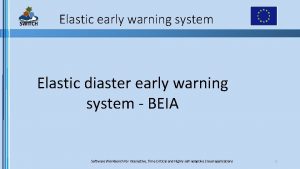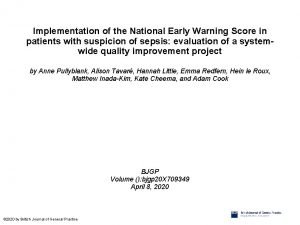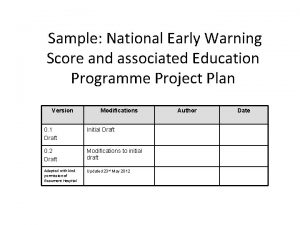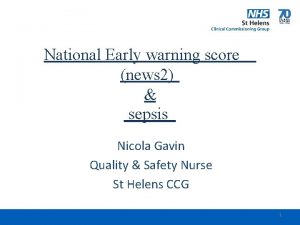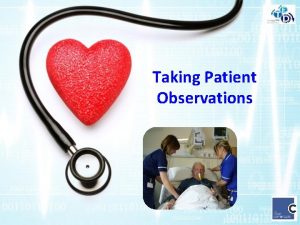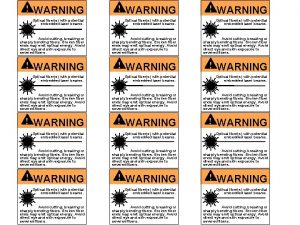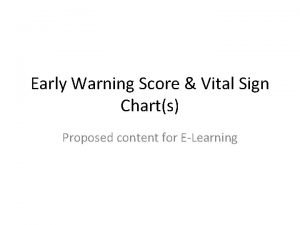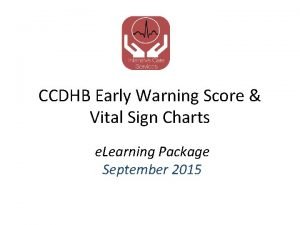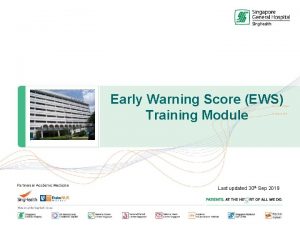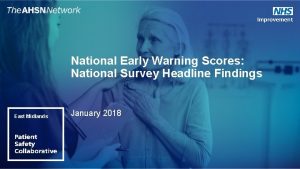The use of the National Early Warning Score



























- Slides: 27

The use of the National Early Warning Score (NEWS) in an old age psychiatry unit Dr Priya Rajyaguru Foundation Year 2 Doctor North Bristol NHS Trust

Introduction • F 2 rotation in old age psychiatry Aug-Dec 2013 • Shock to the system! • Who has done psychiatry here? • We are often the most medically knowledgeable (by consultant’s own admission) • Nurses not medically experienced • No access to secondary care services eg. Regular bloods, xray and other imaging, specialist opinions, medical registrar (!) • If concerned about a patient dial 999

A+E 20 minutes by car

Introduction • Implications for old age psychiatry • Old people have multiple medical comorbidities • Can deteriorate very quickly in the same way as in general medical hospital • Trust had introduced National Early Warning Score (NEWS) system in 2012 • Several experiences on the wards where patients deteriorated without detection • Scoring had not been completed • Action needed

Aim To identify the frequency and accuracy of National Early Warning Score usage in an old age psychiatry unit, to determine if practice met the recommended guidelines appropriate and to implement change where

Background “Track and Trigger” Systems

Background

Background

Methods Phase 1: Initial Audit - Retrospective - Two wards (n=32) - NEWS charts used to gather data - Standards based on Trust guidelines Phase 2: Implementing change - Two week educational period, handovers, posters, teaching - NEWS Trigger-Sticker development Phase 3: Re-audit - Prospective - Two wards (n=27) - NEWS charts used to gather data - Standards as before

Methods Phase 1: Initial Audit a) Standards based on Trust guidelines: • All inpatients should have a full set of physical observations at a minimum of once per week • All inpatients should have a NEWS calculated at a minimum of once per week b) Data collection over 6 weeks, retrospective c) Scoring frequency and accuracy determined

Data collection. NEW Scores

Methods Phase 2: Implementing change a) - Two week educational programme Nursing handovers Clinical skills refresher sessions Q+A forum Posters Positive feedback


Methods Phase 2: Implementing change b) The NEWS-Trigger-Sticker - NEWS charts lacked information regarding what to do based on score - Too expensive to disregard and redesign entire chart - Cost effective and ‘quick-fix’ idea: a sticker - Also served as a reminder to calculate score

Methods b) The NEWS-Trigger-Sticker


Methods Phase 3: Re-audit a) Standards based on Trust guidelines: • All inpatients should have a full set of physical observations at a minimum of once per week • All inpatients should have a NEWS calculated at a minimum of once per week b) Data collection over 6 weeks, prospective c) Scoring frequency and accuracy determined d) NEWS charts used for data collection

Results Initial audit: • 28% of patients had weekly NEWS calculations, of which only 14% were correctly scored • The greatest error amongst incorrect scores was in relation to respiratory rate Graph 1: The percentage of patients in which the NEWS was calculated once per week over the 6 -week period pre-intervention

Results Graph 2: The percentage of patients in which each parameter was measured once per week over the 6 -week period pre-intervention

Results Post intervention: • After the quality improvement 72% of patients had weekly NEWS calculations of which 70% were correctly scored • Accuracy of respiratory rate scoring improved Graph 3: The percentage of patients in which the NEWS was calculated once per week over the 6 -week period post intervention

Results Graph 4: The percentage of patients in which each parameter was measured once per week over the 6 -week period post intervention

Discussion • Many psychiatry wards are separate from acute hospitals and lack medically experienced staff, thus use of the NEWS to aid detection of physical deterioration is particularly important • People with mental illness are at an increased risk of comorbidity 1 • The importance of the NEWS to old age psychiatry as a specialty is also clear, given the frequency of comorbidities in the elderly • Forget Me Not report 2 recommendations

Discussion To provide good psychiatric care also requires good medical care.

Future Steps • To present this at ward manager meetings with view to incorporate across the trust • To propose a ‘refresher week’ every 4 months allowing staff to revise and renew their confidence • To re-audit in other departments

Conclusion • This audit initially identified suboptimal scoring, putting patients at risk • Following cost-effective intervention the NEWS Trigger-Sticker in addition to further education has greatly improved scoring quality, benefiting patient safety in psychiatry settings • Acronym based stickers provide big impact via simple means

References • 1 Mitchell et al; 2009; Quality of medical care for people with and without comorbid mental illness and substance misuse: systematic review of comparative studies; British Journal of Psychiatry; 194: 491 -499 • 2 Forget Me Not: Audit Commission; 2000

Thank you!
 Obstetrics score
Obstetrics score Early warning score
Early warning score Early warning score
Early warning score Fife early warning score
Fife early warning score News vitalparametrar
News vitalparametrar Www.iscd.org
Www.iscd.org Wicew
Wicew Early warning intervention and monitoring system
Early warning intervention and monitoring system Early warning system in disaster management
Early warning system in disaster management Ohsc early warning system
Ohsc early warning system Ohsc
Ohsc Earthquake early warning system japan
Earthquake early warning system japan What is pews
What is pews Early warning signals for employees
Early warning signals for employees Early warning
Early warning Earthquake early warning systems
Earthquake early warning systems Breast cancer anatomy and early warning signs
Breast cancer anatomy and early warning signs Sri lanka tsunami warning system
Sri lanka tsunami warning system Nec activity schedule example
Nec activity schedule example Mews early warning system
Mews early warning system Early cpr and early defibrillation can: *
Early cpr and early defibrillation can: * Brown international academy
Brown international academy Acadience reading diagnostic
Acadience reading diagnostic T score and z score difference
T score and z score difference Early national period education
Early national period education National breast and cervical cancer early detection program
National breast and cervical cancer early detection program National breast and cervical cancer early detection program
National breast and cervical cancer early detection program National early literacy panel
National early literacy panel


